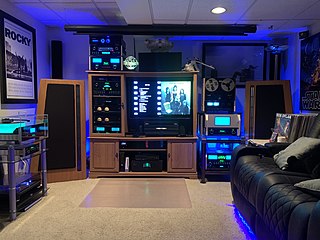
An audio power amplifier amplifies low-power electronic audio signals, such as the signal from a radio receiver or an electric guitar pickup, to a level that is high enough for driving loudspeakers or headphones. Audio power amplifiers are found in all manner of sound systems including sound reinforcement, public address, home audio systems and musical instrument amplifiers like guitar amplifiers. It is the final electronic stage in a typical audio playback chain before the signal is sent to the loudspeakers.

Sound Blaster is a family of sound cards and audio peripherals designed by Singaporean technology company Creative Technology. The first Sound Blaster card was introduced in 1989.

CSR plc was a multinational fabless semiconductor company headquartered in Cambridge, United Kingdom. Its main products were connectivity, audio, imaging and location chips. CSR was listed on the London Stock Exchange and was a constituent of the FTSE 250 Index until it was acquired by Qualcomm in August 2015. Under Qualcomm's ownership, the company was renamed Qualcomm Technologies International, Ltd.
PS Audio is an American company specializing in high-fidelity audio components equipment for audiophiles and the sound recording industry. It currently produces audio amplifiers, preamplifiers, power related products, digital-to-analog converters, streaming audio, music management software and cables.
Harman Kardon is a division of US-based Harman International Industries, an independent subsidiary of Samsung Electronics. Harman Kardon was originally founded in Westbury, New York, in 1953 by business partners Sidney Harman and Bernard Kardon.

ReVox is a brand name, registered by Studer on 27 March 1951 for Swiss audio equipment.
Founded by David Hafler and Ed Laurent in Philadelphia, Pennsylvania in 1955, Dynaco was an American hi-fi audio system manufacturer popular in the 1960s and 1970s for its wide range of affordable, yet high quality audio components.. Its best known product was the ST-70 tube stereo amplifier. They also manufactured other tube and solid state amplifiers, preamplifiers, radio tuners and bookshelf loudspeakers. Dynaco was liquidated in 1980, and the trademark is now owned by Radial Engineering Ltd.

Naim Audio is a British hi-fi manufacturer based in Wiltshire, United Kingdom.
Denon is a Japanese electronics company dealing with audio equipment. The Denon brand came from a merger of Denki Onkyo and others in 1939, but it originally started as Nippon Chikuonki Shoukai in 1910 by Frederick Whitney Horn, an American entrepreneur.
Roksan is a British manufacturer of high fidelity audio products for domestic use, based in Rayleigh, Essex. It is best known for its influential and innovative design for hi-fi equipment, and in particular its Xerxes platform for playing LP records.
Musical Fidelity is a British producer of high-end audio equipment focusing on streaming music players, and its core product range of amplifiers of various types. Other products have included headphones, Digital-Analog Converters (DACs), CD players, Bluetooth Receivers, ‘all-in-one systems’. Founded in the United Kingdom in 1982, they are known for their unusual industrial design, Nuvistor tube use and Class-AB amplifiers.
Armstrong Audio, originally called Armstrong Wireless and Television Ltd., was a British manufacturer of radios and other audio equipment based in London, England. Founded by Claude Charles Jackson in 1932.
Audio Partnership Plc is a British manufacturer of hi-fi, home cinema and home automation products, which was founded in 1994.
A&R Cambridge Ltd (Arcam) is a British manufacturer of hi-fi equipment based in the Cambridge Innovation Park, Waterbeach, Cambridgeshire, England. It was established in 1976 by science and engineering students from the University of Cambridge. Since July 2017, it has been a part of South Korean company Samsung Electronics through its American subsidiary Harman International Industries.
Audiolab is a British manufacturer of audio equipment. It specializes in affordable systems and has a range of stereo and surround sound systems. During its ownership under McLaren Group it was named TAGMcLaren Audio.
Luxman is a brand name of Japanese Luxman Corporation (ラックスマン株式会社) that manufactures luxury audio components. Luxman produces a variety of high-end audio products, including turntables, amplifiers, receivers, tape decks, CD players and speakers.

What Hi-Fi? is a website and magazine published by Future. It is a buying guide for consumer electronics, featuring news, reviews and features on hi-fi, home cinema, television and home audio. The website, whathifi.com, is updated daily, while the magazine is published thirteen times per year.

Home audio systems refer to audio consumer electronics designed for home entertainment, such as integrated systems like shelf stereos and music centers, as well as individual components like loudspeakers and surround sound receivers. The evolution of home audio began with Edison's phonograph, transitioning from monaural to stereophonic sound in the 1950s and 60s. The term "hi-fi" emerged, highlighting sound accuracy and minimal distortion. Audio equipment evolved from large wooden cabinets to compact units. The 1970s introduced enhancements like quadraphonic sound and technologies like Dolby Pro Logic. The 1970s and 1980s also saw the rise of component-based stereo systems. Cassette decks became a staple in the 1970s. Integrated systems, termed "music centers" gained popularity in the 1980s. Table systems and compact radio receivers emerged as entertainment devices, with some offering features like cassette players and CD functionalities. Audiophile systems prioritize high-quality music formats and specialized equipment like premium turntables, digital-to-analog converters, and other high-end devices, with some enthusiasts preferring the unique sound characteristics of vinyl records and vacuum tubes. Modern systems often emphasize home cinema applications to enhance the audio experience beyond standard TV speakers.

John Alexander Westlake is a British–Czech Hi Fi designer.
Devialet is a French audio technology company that produces a line of speakers (Phantom) and amplifiers (Expert). It was founded in 2007 in Paris.










